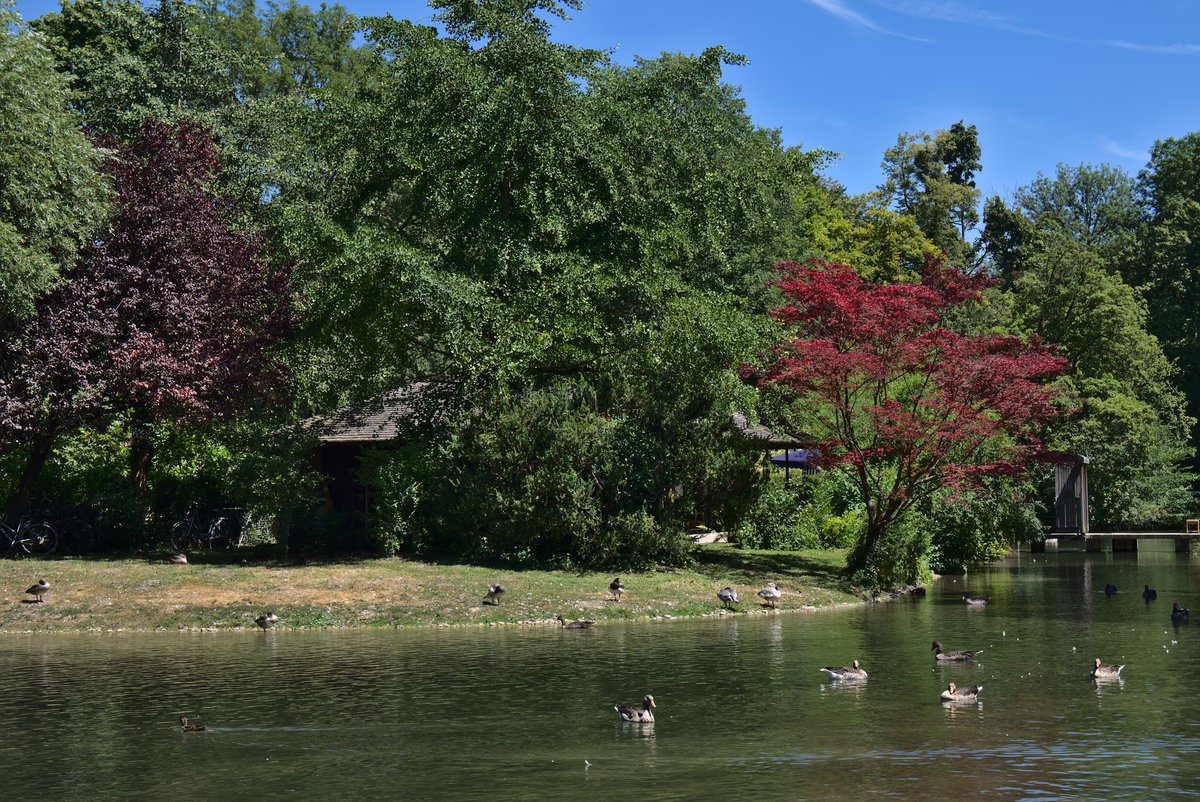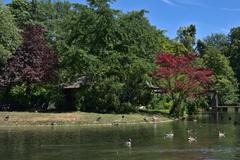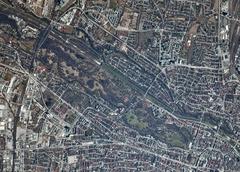
Englischer Garten Munich: Visiting Hours, Tickets, and Complete Guide
Date: 14/06/2025
Introduction
Nestled in the heart of Munich, the Englischer Garten stands out as one of the world’s largest and most celebrated urban parks. Spanning over 375 hectares (910 acres), it offers a captivating blend of natural landscapes, cultural landmarks, and vibrant social life—surpassing even New York’s Central Park in size (Introducing Munich; Lonely Planet). Whether you’re seeking tranquility, cultural experiences, or outdoor recreation, this comprehensive guide will help you make the most of your visit to Munich’s historic Englischer Garten.
Historical Overview
Origins and Development
Commissioned in 1789 by Elector Karl Theodor and designed by Sir Benjamin Thompson (Count Rumford), the Englischer Garten was founded as a revolutionary public park intended for the enjoyment and wellbeing of all Munich residents—a novel concept at a time when most green spaces were reserved for aristocracy (History Curator; Wikipedia). Modeled after the naturalistic English landscape garden style, it features rolling meadows, meandering streams, and scenic groves that invite relaxation and exploration (Green Packs).
Cultural Significance
The park quickly became a symbol of Munich’s openness and sense of community. Over the centuries, it has evolved to incorporate multicultural influences, artistic traditions, and spaces for social movements, such as the official area for nude sunbathing at Schönfeldwiese—a reflection of the city’s progressive spirit (Family Abroad). Notable additions include the Chinese Tower, Japanese Teahouse, and the Eisbach surfing wave, each contributing to the park’s global appeal.
Key Attractions and Landmarks
The Chinese Tower and Beer Garden
The Chinese Tower (Chinesischer Turm), built in 1790, is an iconic wooden pagoda surrounded by one of Munich’s largest beer gardens. Seating up to 7,000 guests, it offers classic Bavarian fare and local beers in a convivial setting, often accompanied by live music (Family Abroad; theculturalpocalypse.com).
Monopteros
The Monopteros is a Greek-inspired circular temple perched on a hill, providing sweeping views of the park and Munich’s skyline. It’s a favorite spot for photography and sunset viewing (awanderingturtle.com).
Eisbachwelle (Eisbach Wave)
At the park’s southern end lies the Eisbachwelle, a unique standing wave on the Eisbach River. Surfers from around the world come here to ride the wave year-round, offering a thrilling spectacle for visitors (thebrokebackpacker.com).
Japanese Teahouse
Located on a small island in the Schwabinger Bach, the Japanese Teahouse was a gift from Japan in 1972. It hosts traditional tea ceremonies and cultural events, providing a peaceful retreat within the park.
Recreational Activities
Walking, Jogging, and Cycling
The Englischer Garten boasts nearly 80 kilometers of scenic paths suitable for walking, jogging, and cycling (awanderingturtle.com). Bike rentals are available near main entrances, and guided tours can enrich your visit.
Picnicking and Sunbathing
Expansive lawns throughout the park invite visitors to picnic, sunbathe, or simply relax. The relaxed atmosphere is perfect for families and friends to unwind (munich.travel).
Boating
In the northern section, Kleinhesseloher See offers rowboat rentals, perfect for a serene experience on the lake, surrounded by lush greenery (awanderingturtle.com).
Swimming and River Activities
The park’s streams, including the Eisbach and Schwabinger Bach, are popular for wading and swimming during warmer months. However, swimming in the Eisbach is advised only for strong swimmers due to rapid currents (thebrokebackpacker.com).
Cultural Experiences
Beer Gardens and Cuisine
The park’s beer gardens, especially at the Chinese Tower and Seehaus, are social hubs offering authentic Bavarian food and drink. Sharing tables with locals and enjoying live music are integral parts of the experience (theculturalpocalypse.com).
Events and Festivals
Annual events include the Kocherlball in July, open-air concerts, and seasonal festivals, making the park a lively gathering place throughout the year (munich.travel).
Nature and Wildlife
The park’s diverse flora includes oaks, chestnuts, and maples, supporting an array of wildlife such as ducks, swans, and kingfishers. The careful balance between natural beauty and human enjoyment is maintained through thoughtful stewardship (munich.travel).
Practical Visitor Information
Opening Hours
The Englischer Garten is open 24 hours a day, year-round. While the park itself is always accessible, facilities like beer gardens and boat rentals have specific operating hours (urtrips.com).
Entry Fees
Entry to the park is free. Tickets may only be required for special events or guided tours.
Accessibility
Main paths are flat and wheelchair-friendly, though some natural trails may be uneven. Restrooms, playgrounds, and food kiosks are available at key locations.
Getting There
- Public Transport: The park is easily accessed via U-Bahn stations (Universität, Münchner Freiheit, Giselastraße) and several tram and bus routes (awanderingturtle.com).
- Biking: Munich’s bike-friendly streets make cycling to and through the park convenient (munich.travel).
- Car: Parking is limited; public transport is recommended (englischer-garten-muenchen-infos.de).
Facilities
- Toilets and changing areas at major sites
- Free Wi-Fi at main beer gardens
- Bike and boat rentals near park entrances and lakes
- Playgrounds and picnic areas
- No on-site parking; use public transport
Safety and Etiquette
- Swim only in designated areas and use caution in strong currents
- Cyclists should stick to marked paths and yield to pedestrians
- Keep noise levels down in tranquil zones
- Dispose of litter responsibly and avoid feeding wildlife
Visitor Tips
- Arrive early for a peaceful experience
- Take a guided tour for historical insights and hidden gems (munich.travel)
- Dress in layers and bring a rain jacket, especially in spring and early summer (wanderlog.com)
- Carry cash for beer gardens and kiosks
Frequently Asked Questions (FAQ)
Q: What are the Englischer Garten’s opening hours?
A: Open 24 hours a day, all year.
Q: Is there an entrance fee?
A: No, entry is free.
Q: Are guided tours available?
A: Yes, walking, cycling, and rickshaw tours can be booked.
Q: Is the park wheelchair accessible?
A: Main paths are accessible; some areas may be uneven.
Q: Are dogs allowed?
A: Yes, keep them on a leash in busy areas.
Q: Can I rent bikes or boats?
A: Yes, rentals are available near main entrances and at Kleinhesseloher See.
Nearby Attractions
The Englischer Garten’s central location makes it easy to combine your visit with nearby attractions such as the Nymphenburg Palace, Bavarian National Museum, Residenz Palace, and Marienplatz.
Summary and Recommendations
The Englischer Garten is a living symbol of Munich’s commitment to public green spaces that foster community, culture, and ecological wellbeing (History Curator; Green Packs). Its combination of scenic landscapes, cultural landmarks, and recreational opportunities ensures a memorable experience for every visitor (Munich Tourism; Lonely Planet). Open year-round and free to enter, the park invites you to enjoy Munich’s traditions, festivals, and everyday leisure in a truly unique setting.
Plan your visit:
- Check official park information and the Munich tourism portal) for updates on events and facilities.
- Consider a guided tour for a deeper understanding of the park’s history and highlights.
- Download the Audiala app for up-to-date tips, maps, and event information.
References
- Introducing Munich
- History Curator
- Green Packs
- Munich Tourism
- Wikipedia
- Lonely Planet
- Family Abroad
- urtrips.com
- Munich Travel
Enjoy your time in Munich’s green heart! For more travel inspiration, download the Audiala app, follow us on social media, and explore related articles on Munich’s historical and cultural gems.






































































































